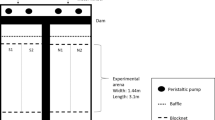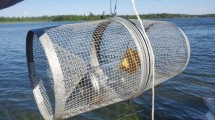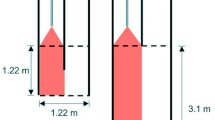Abstract
Chemical characterization of damage-released alarm cues in ostariophysan fishes has lagged far behind the study of the ecological role that these cues play in behavioral decision-making of prey fishes. Chondroitin sulfate has been identified as a putative component of alarm cue based on two laboratory studies of zebrafish, Danio rerio, and the northern studfish, Fundulus catenatus. The fathead minnow, Pimephales promelas, is a model organism in the study of chemically mediated predator–prey interactions, in part because they can be studied in the laboratory and under field conditions. Here, we conducted a field experiment on wild populations of fathead minnows, to test for area avoidance of chondroitin sulfate relative to conspecific skin extract (containing alarm cues = positive control) or water (negative control). We repeated the experiment in two small lakes in central Minnesota using minnow traps containing blocks of sponge with one of the three test cues. We found that fathead minnows avoided traps chemically labeled with conspecific alarm cue more than control traps labeled with water, and that the number of minnows caught in traps labeled with chondroitin sulfate was intermediate between alarm cue traps and water traps. These data are consistent with laboratory findings that chondroitin sulfate is a component of alarm cue, but that other species-specific compounds are needed for a full behavioral response.




Similar content being viewed by others
References
Argentini M (1976) Isolerung des Schreckstoffes aus der Haut der Elritze Phoxinus phoxinus L. Dissertation, Universität Zürich
Brown GE (2003) Learning about danger: chemical alarm cues and local risk assessment in prey fishes. Fish Fish 4:227–234. doi:10.1046/j.1467-2979.2003.00132.x
Brown GE, Adrian JC, Smyth E, Leet H, Brennan S (2000) Ostariophysan alarm pheromones: laboratory and field tests of the functional significance of nitrogen oxides. J Chem Ecol 26:139–154. doi:10.1023/A:1005445629144
Brown GE, Adrian JC, Shih ML (2001) Behavioural responses of fathead minnows to hypoxanthine-3-N-oxide at varying concentrations. J Fish Biol 58:1465–1470. doi:10.1111/j.1095-8649.2001.tb02301.x
Chivers D, Smith R (1998) Chemical alarm signaling in aquatic predator-prey systems: a review and prospectus. Écoscience 5:338–352. doi:10.1080/11956860.1998.11682471
Chivers DP, Brown GE, Smith RJF (1996) The evolution of chemical alarm signals: attracting predators benefits alarm signal senders. Am Nat 148:649–659. doi:10.1086/285945
Chivers DP, Mirza RS, Johnston JG (2002) Learned recognition of heterospecific alarm cues enhances survival during encounters with predators. Behaviour 139:929–938. doi:10.1163/156853902320387909
Chivers DP, Wisenden BD, Hindman CJ, Michalak TA, Kusch RC, Kaminskyj SGW, Jack KL, Ferrari MCO, Pollock RJ, Halbgewachs CF, Pollock MS, Alemadi S, James CT, Savaloja RK, Goater CP, Corwin A, Mirza RS, Kiesecker JM, Brown GE, Adrian JCJr, Krone PH, Blaustein AR, Mathis A (2007) Epidermal “alarm substance” cells of fishes are maintained by non-alarm functions: possible defence against pathogens, parasites and UVB radiation. Proc Roy Soc Lond B 274:2611–2620. doi:10.1098/rspb.2007.0709
Decho AW, Browne KA, Zimmer-Faust RK (1998) Chemical cues: why basic peptides are signal molecules in marine environments. Limnol Oceanogr 43:1410–1417. doi:10.4319/lo.1998.43.7.1410
Døving KB, Hamdani EH, Hoglund E, Kasumyan AO, Tuvikene A (2005) Review of the chemical and physiological basis of alarm reactions in cyprinids. In: Reutter K, Kapoor BG (eds) Fish chemosenses. Science Publishers, Enfield NH, pp 133–164
Farnsley S, Kuhajda B, George A, Klug H (2016) Fundulus catenatus (northern studfish) response to the potential alarm cue chondroitin sulfate. Southeast Nat 15:523–533. doi:10.1656/058.015.0315
Ferrari MCO, Wisenden BD, Chivers DP (2010) Chemical ecology of predator-prey interactions in aquatic ecosystems: a review and prospectus. Can J Zool 88:698–724. doi:10.1139/Z10-029
Kasumyan AO, Lebedeva NY (1979) New data on the nature of the alarm pheromone in cyprinids. J Ichthyol 19:109–114
Kasumyan AO, Ponomarev VY (1987) Biochemical features of alarm pheromone in fish of the order cypriniformes. J Evol Biochem Physiol - Eng Tr 23:20–23
Kelley JL, Magurran AE (2003) Learned predator recognition and antipredator responses in fishes. Fish Fish 4:216–226. doi:10.1046/j.1467-2979.2003.00126.x
Lebedeva NY, Malyukina GA, Kasumyan AO (1975) The natural repellent in the skin of cyprinids. J Ichthyol 15:472–480
Lima S, Dill L (1990) Behavioral decisions made under the risk of predation: a review and prospectus. Can J Zool 68:619–640. doi:10.1139/z90-092
Mathis A, Smith RJF (1992) Avoidance of areas marked with a chemical alarm substance by fathead minnows (Pimephales promelas) in a natural habitat. Can J Zool 70:1473–1476. doi:10.1139/z92-203
Mathuru AS, Kibat C, Cheong WF, Shui G, Wenk MR, Friedrich RW, Jesuthasan S (2012) Chondroitin fragments are odorants that trigger fear behavior in fish. Curr Biol 22:538–544. doi:10.1016/j.cub.2012.01.061
Mirza RS, Chivers DP (2002) Brook charr (Salvelinus fontinalis) can differentiate chemical alarm cues produced by different size classes of conspecifics. J Chem Ecol 28:555–564. doi:10.1023/A:1014544112763
Nelson JS (2006) Fishes of the world. Wiley, New Jersey
Parra KV, Adrian JCJr, Gerlai R (2009) The synthetic substance hypoxanthine 3-N-oxide elicits alarm reactions in zebrafish (Danio rerio). Behav Brain Res 205:336–341. doi:10.1016/j.bbr.2009.06.037
Pfeiffer W, Riegelbauer G, Meier G, Scheibler B (1985) Effect of hypoxanthine-3(N)-oxide and hypoxanthine-1(N)-oxide on central nervous excitation of the black tetra Gymnocorymbus ternetzi (Characidae, Ostariophysi, Pisces) indicated by dorsal light response. J Chem Ecol 11:507–523. doi:10.1007/BF00989562
Ralphs JR, Benjamin M (1992) Chondroitin and keratan sulphate in the epidermal club cells of teleosts. J Fish Biol 40:473–475. doi:10.1111/j.1095-8649.1992.tb02594.x
Russell ST, Kelley JL, Graves JA, Magurran AE (2004) Kin structure and shoal composition dynamics in the guppy, Poecilia reticulata. Oikos 106:520–526. doi:10.1111/j.0030-1299.2004.12847.x
Siegel S, Castellan NJJr (1988) Nonparametric statistics for the behavioral sciences. McGraw-Hill, New York
Smith RJF (1986) Evolution of alarm signals: role of benefits of retaining group members or territorial neighbors. Am Nat 128:604–610
Smith RJF (1992) Alarm signals in fishes. Rev Fish Biol Fish 2:33–63. doi:10.1007/BF00042916
Sorensen PW, Johnson NS (2016) Theory and application of semiochemicals in nuisance fish control. J Chem Ecol 42:698–715. doi:10.1007/s10886-016-0729-4
Weldon PJ (1983) The evolution of alarm pheromones. In: Muller-Schwarze D, Silverstein RM (eds) Chemical Signals in Vertebrates 3. Plenum, New York, pp 309–312. doi:10.1007/978-1-4757-9652-0_20
Wisenden BD (2008) Active space of chemical alarm cue in natural fish populations. Behaviour 145:391–407. doi:10.1163/156853908783402920
Wisenden BD (2015a) Chemical cues that indicate risk of predation. In: Sorensen PW, Wisenden BD (eds) Fish pheromones and related cues. Wiley-Blackwell Press, Ames IA, pp 131–148
Wisenden BD (2015b) The cue-signal continuum: an evolutionary trajectory for semiochemicals in fishes. In: Sorensen PW, Wisenden BD (eds) Fish pheromones and related cues. Wiley-Blackwell Press, Ames IA, pp 149–158
Wisenden BD, Barbour K (2005) Antipredator responses to skin extract of redbelly dace, Phoxinus eos, by free-ranging populations of redbelly dace and fathead minnows, Pimephales promelas. Environ Biol Fish 72:227–233. doi:10.1007/s10641-004-8753-6
Wisenden BD, Pollock MS, Tremaine RJ, Webb JM, Wismer ME, Chivers DP (2003) Synergistic interactions between chemical alarm cues and the presence of conspecific and heterospecific fish shoals. Behav Ecol Sociobiol 54:485–490. doi:10.1007/s00265-003-0653-9
Wisenden BD, Vollbrecht KA, Brown JL (2004) Is there a fish alarm cue? Affirming evidence from a wild study. Anim Behav 67:59–67. doi:10.1016/j.anbehav.2003.02.010
Wisenden BD, Rugg M, Korpi N, Fuselier L (2009) Lab and field estimates of active time of chemical alarm cues of a cyprinid fish and an amphipod crustacean. Behaviour 146:1423–1442. doi:10.1163/156853909X440998
Acknowledgements
Protocols used in the course of this study were reviewed and approved by the Institutional Animal Care and Use Committee (IACUC) of the University of Minnesota (protocol 1412-32136A).
Author information
Authors and Affiliations
Corresponding author
Additional information
Handling Editor: Michael Heethoff.
Rights and permissions
About this article
Cite this article
Faulkner, A.E., Holstrom, I.E., Molitor, S.A. et al. Field verification of chondroitin sulfate as a putative component of chemical alarm cue in wild populations of fathead minnows (Pimephales promelas). Chemoecology 27, 233–238 (2017). https://doi.org/10.1007/s00049-017-0247-z
Received:
Accepted:
Published:
Issue Date:
DOI: https://doi.org/10.1007/s00049-017-0247-z




